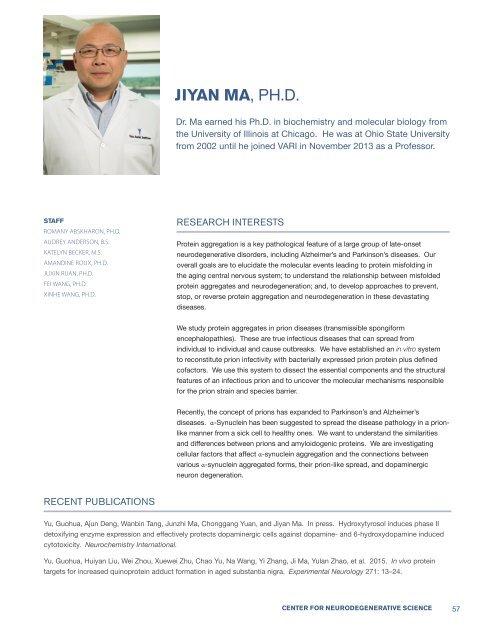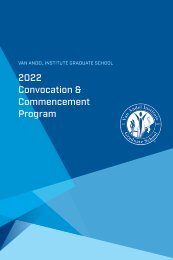2016 Scientific Report
You also want an ePaper? Increase the reach of your titles
YUMPU automatically turns print PDFs into web optimized ePapers that Google loves.
JIYAN MA, PH.D.<br />
Dr. Ma earned his Ph.D. in biochemistry and molecular biology from<br />
the University of Illinois at Chicago. He was at Ohio State University<br />
from 2002 until he joined VARI in November 2013 as a Professor.<br />
STAFF<br />
ROMANY ABSKHARON, PH.D.<br />
AUDREY ANDERSON, B.S.<br />
KATELYN BECKER, M.S.<br />
AMANDINE ROUX, PH.D.<br />
JUXIN RUAN, PH.D.<br />
FEI WANG, PH.D.<br />
XINHE WANG, PH.D.<br />
RESEARCH INTERESTS<br />
Protein aggregation is a key pathological feature of a large group of late-onset<br />
neurodegenerative disorders, including Alzheimer’s and Parkinson’s diseases. Our<br />
overall goals are to elucidate the molecular events leading to protein misfolding in<br />
the aging central nervous system; to understand the relationship between misfolded<br />
protein aggregates and neurodegeneration; and, to develop approaches to prevent,<br />
stop, or reverse protein aggregation and neurodegeneration in these devastating<br />
diseases.<br />
We study protein aggregates in prion diseases (transmissible spongiform<br />
encephalopathies). These are true infectious diseases that can spread from<br />
individual to individual and cause outbreaks. We have established an in vitro system<br />
to reconstitute prion infectivity with bacterially expressed prion protein plus defined<br />
cofactors. We use this system to dissect the essential components and the structural<br />
features of an infectious prion and to uncover the molecular mechanisms responsible<br />
for the prion strain and species barrier.<br />
Recently, the concept of prions has expanded to Parkinson’s and Alzheimer’s<br />
diseases. α-Synuclein has been suggested to spread the disease pathology in a prionlike<br />
manner from a sick cell to healthy ones. We want to understand the similarities<br />
and differences between prions and amyloidogenic proteins. We are investigating<br />
cellular factors that affect α-synuclein aggregation and the connections between<br />
various α-synuclein aggregated forms, their prion-like spread, and dopaminergic<br />
neuron degeneration.<br />
RECENT PUBLICATIONS<br />
Yu, Guohua, Ajun Deng, Wanbin Tang, Junzhi Ma, Chonggang Yuan, and Jiyan Ma. In press. Hydroxytyrosol induces phase II<br />
detoxifying enzyme expression and effectively protects dopaminergic cells against dopamine- and 6-hydroxydopamine induced<br />
cytotoxicity. Neurochemistry International.<br />
Yu, Guohua, Huiyan Liu, Wei Zhou, Xuewei Zhu, Chao Yu, Na Wang, Yi Zhang, Ji Ma, Yulan Zhao, et al. 2015. In vivo protein<br />
targets for increased quinoprotein adduct formation in aged substantia nigra. Experimental Neurology 271: 13–24.<br />
CENTER FOR NEURODEGENERATIVE SCIENCE 57
















